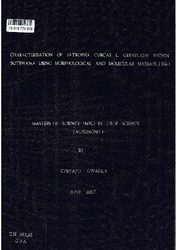| dc.contributor.advisor | Ngwako, Samodimo | |
| dc.contributor.advisor | Batlang, Utlwang | |
| dc.contributor.author | Gwafila, Chiyapo | |
| dc.date.accessioned | 2022-03-01T10:16:26Z | |
| dc.date.available | 2022-03-01T10:16:26Z | |
| dc.date.issued | 2017-06 | |
| dc.identifier.uri | https://hdl.handle.net/13049/364 | |
| dc.description | Thesis MSc, 2017 BUAN | en_US |
| dc.description.abstract | Jatropha curcas L. is an undomesticated plant species that has recently received great attention
for its utilization in biofuel production in many countries including Botswana. The main goal of
this study was to identify unique genotypes or sources of genetically diverse genotypes that wilt
serve as parental line for Jatropha curcas breeding programme in Botswana.
The study was conducted at two sites at Botswana University Agriculture and Natural resources
Tissue Culture Laboratory and Department of Agricultural Research Station Nursery during the
period of October 2015 to May 2016. A total of 30 Jatropha curcas accessions were used. Three
trees per accessions were randomly tagged for data collection in the field. Accessions were
characterized for 16 quantitative and 8 qualitative characters. The results indicated considerable
variation for quantitative characters, as well as significant morphological difference in almost all
the characters. The qualitative characters revealed substantial amount of variability among the
accessions except in fruit shape, stem color and flower color. Multivariate cluster and principal
coordination analysis based on morphological characters grouped the accessions into four
clusters at dissimilarity coefficient of approximately 1.37 indicating a wider variation. Principal
component analysis identified characters that accounted for the total variation. The first five
principal components accumulated total variation of 71.74%. This was mostly associated with
the quantitative characters. This indicates the most important characters to consider when
characterization Jatropha curcas morphological under limited resources.
viMolecular characterization involved genomic DNA isolated from young leaves of the same 30
Jatroplia curcas accessions using CTAB DNA extraction protocol. DNA was confirmed with a
Nano Drop as well 2% agarose gel with ethidium bromide staining. A total of 22 SSR primers
pairs were tested with DNA sample for reproducible amplification following the touchdown
50/45 PCR program. Four markers did not amplify DNA samples for all accessions and were
discarded. The scored data for 18 markers was assessed for polymorphism by calculating the
polymorphic information content (PIC). PIC value for each marker was 0.00 indicating lack of
informativeness. The cluster analysis revealed four distinct clusters at 0.85 genetic similarity
coefficients and this indicates narrow genetic diversity. The markers that accounted for the total
variation were identified through principal component analysis and were associated with four
principal components which accounted for 73.91% of the total cumulative variance.
Correlation of morphological and molecular markers showed negative, positive and no
correlation relationships. A total of eight morphological characters and six molecular markers
correlated positively with r values ranging from 0.557 to 0.662. Whereas negative and no
correlation relationship revealed by majority of the markers. This indicates that microsatellite
markers indeed do not sample the same genomic regions with genes that control the expression
of phenotypes. | en_US |
| dc.language.iso | en | en_US |
| dc.publisher | Botswana University of Agriculture & Natural Resources | en_US |
| dc.subject | Genetic diversity | en_US |
| dc.subject | Morphological markers | en_US |
| dc.subject | Quantitative and Qualitative traits | en_US |
| dc.subject | Molecular markers | en_US |
| dc.subject | SSR | en_US |
| dc.subject | Jatropa curcas | en_US |
| dc.title | Characterisation of Jatropha curcas L. germplasm within Botswana using morphological and molecular markers (SSR) | en_US |
| dc.type | Article | en_US |

